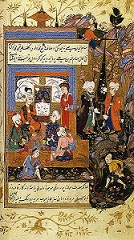The 13th-century visionary was so much more than a poet.

Everybody loves Rumi. Well, not anyone who is unable to escape the mental boundaries of 21st-century America. But it seems these days that every other person loves Rumi. He has been the bestselling poet in America for several years now, even though he died in 1273.
So why is the English-speaking world so taken with this pre-Renaissance Muslim cleric from Konya, Turkey? Like Emily Dickinson, Rumi left humanity with hundreds of short, intense, idiosyncratic poems that (with a minimum of elucidation) transport readers beyond the physical world and deeply into the mystical.
Love was the great subject of these meditations, and Rumi distinguished nothing between the temporal and the spiritual. For him, these two states were the same, and his symbolism and language unite the earthly and celestial realms for modern-day readers. If this was all he had done, his writing would still be strewn among the inspirational books in your local bookstore.
But if you love this Rumi, it’s time to go further and understand the greater magnitude of his achievements. He helped to establish the school which we now know as the Whirling Dervishes, an ecstatic Sufi Islam sect. He was a widely traveled and renowned sheikh in his day. He was beloved and famous while he lived, but nothing interfered with his dedication to conveying his messages to everyday people.
Rumi’s magnum opus is a work less well-known because it is three times longer than Dante’s 14,000-line Divine Comedy. Intending, like Dante, to share with his readers the path to salvation, Rumi recited, over the last seven years of his life, in Persian, what became six volumes of his oceanic understanding of the Koran and the spiritual life. The Masnavi is often referred to as “the Persian Koran.”
If you’re squeamish about delving into Koranic narrative and philosophy, here is the great secret to Rumi’s universal appeal as an author: Sufi Islam, to which Rumi adhered (as Prince created music, or as Ichiro Suzuki plays baseball), is less about the outward showings of religiosity, the legal requirements of submission to Allah (the shariah), than the inner journey to union with the mystic, discovering the path of love for Allah and the turning universe (the haqiqah).
The requirements of haqiqah are eerily similar to the disciplines of Buddhism: acknowledgement of suffering, identification of where suffering comes from (desire), and devotion to the way of attaining equanimity and bliss in the fervid and bilious temporal world.
Rumi is free to believe the Koran and to internalize the Prophet’s rendering of God’s word any way he wants. So, let’s talk about the Masnavi (as we would Thomas Jefferson’s writing in the Declaration of Independence, or Abraham Lincoln’s Gettysburg Address) as the manifestation of a believer in, an ecstatic worshipper of, and beatific teacher of, the great human ideal — that we can improve ourselves and attain our own salvation.
No one book has been more crucial to my understanding of the Masnavi than Seyed Ghahreman Safavi and Simon Weightman’s Rumi’s Mystical Design: Reading the Masnavi, Book One. In a word, they have revealed a “syn-optic” vision of the work. In three dimensions, it is as if Rumi’s structures are the many chambers of a great mosque, which Rumi is himself wandering through, assessing the tapestries, the stained-glass windows, the buttresses, the paintings, the columns, the vaults, all the exquisite details of a single artist’s epic vision.
And Safavi and Weightman say that Rumi intended this effect, no less than Dante did, or Michelangelo or Frank Lloyd Wright at their most sublime. Rumi meant for you to follow him through this building, like the Selimiye Mosque, as he revealed his intent line by line, brick by brick.
I only hope that conveys briefly the towering intellectual achievement this work is, certainly comparable to the Arabian Nights. But where Scheherazade perhaps only meant to continue her life as well as to teach her husband and all humanity about mercy, Rumi means for you to be with him at the pinnacle and crossroads of human understanding.
Few men or women have ever attained a higher degree of personal spiritual seeking and fulfillment than Rumi. With the Masnavi, he meant to leave the record of his journey, and his understanding (which also makes it a complicated object of study as opposed to a beloved work of art — unless you are the kind of person who is convinced by such an essay as this to run off to learn about the Masnavi — and if so, please let me know!). It’s an intimidating piece to approach, especially with ignorance about Islam and its stories.
Have you ever read the Koran? I have, and the Masnavi is far more entertaining. They both have a didactic intent, but Rumi wasn’t bound to speak the exact words of Allah. He was free to gather in his phantasmagorical intellect and share the bounty of his genius. There can be no other word for it. He was like Mozart and Michael Jackson rolled into one.
By all means, enjoy Rumi on your calendars, your schmaltzy cards, and in your meditation books, but he wasn’t a lightweight. He was like Shakespeare, and it’s our loss if we don’t know that about any human being, no matter if he is an 850-year-old Muslim, a transplanted Afghani, and an ecstatic dancer in the streets.
After all, everybody loves Rumi for a good reason.
Y.S. Fing is a composition lecturer at a local university and a literary gadfly in the DC area. Recently, he has been experimenting with short essay form in Fingism and Finglish.

_1_80_119.png)